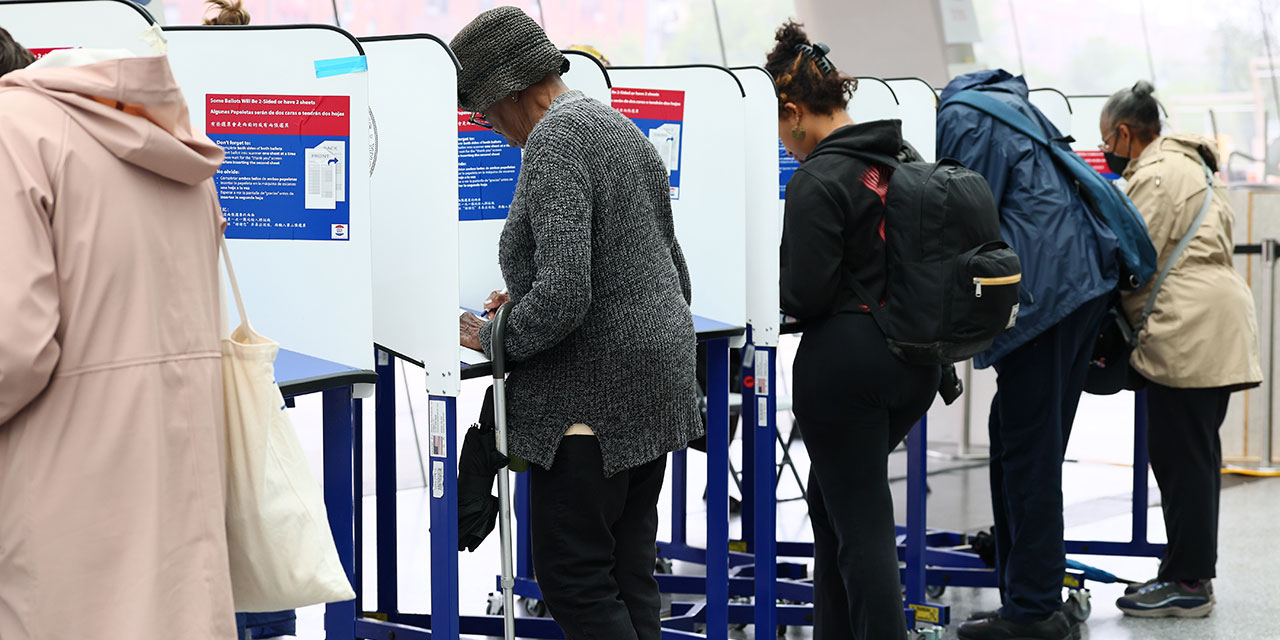
It’s Primary Day in New York City. After months of speculation, Democratic voters will decide their party’s nominee for mayor this November. The city’s second mayoral primary to use ranked-choice voting (RCV) will almost certainly come down to former governor Andrew Cuomo and upstart socialist Assemblyman Zohran Mamdani.
While the results may not be known for weeks, the winner will not coast to a coronation in November as usual. That race is shaping up to be a five-way contest and quite possibly the strangest local election in at least half a century.
Finally, a reason to check your email.
Sign up for our free newsletter today.
The final polls show Cuomo and Mamdani in a tight contest. Last week, a Marist poll found Cuomo beating Mamdani 54–45 percent in seven rounds of ranking. The Manhattan Institute’s poll, also released last week, found Cuomo winning 56–44 percent in ten rounds.
An Emerson College poll released yesterday, however, found Mamdani overtaking Cuomo in eight rounds, 52-48 percent. Despite the torrent of recent local press about Mamdani, he still faces lower name recognition than Cuomo, who occupied the governor’s mansion for almost 11 years and has been politically active for nearly his entire life.
With early voting now completed, the Board of Elections announced Sunday night that 384,338 voters had checked in. By comparison, in 2021, 190,744 of the total 1.01 million ballots cast, or 18.8 percent, opted to vote early.
At first glance, more than doubling the early voting numbers might signal a sizable increase in turnout compared with four years ago. But the two elections aren’t easily comparable, given that the pandemic encouraged more absentee voting, which doesn’t count toward the early voting total.
Voters anticipating 100-degree temperatures today likely cast their ballots last week, and many New Yorkers may simply be getting used to voting early, too. Primary Day’s share of the total turnout could thus turn out to be lower than it was four years ago.
Though the early vote count seems to be helping Mamdani, it’s far from clear how much it will do so. In general, older voters are slightly more likely to vote early, which bodes well for Cuomo. Younger voters appear to have significantly stepped up their early voting compared with 2021, however, setting up a barbell-shaped age distribution of early voters. Last week’s Manhattan Institute poll showed that Mamdani receives about 60 percent of first-ranked choices from the 18-to-34 demographic. The more young voters participating, the better Mamdani’s chances.
However things go, the primary has vastly exceeded prior elections’ independent political spending. Unlike candidates’ campaigns, which can spend a total of only about $7.9 million in the primary as a condition of participating in the public matching-funds program, political action committees can spend unlimited amounts. The Cuomo-aligned Fix the City PAC has raised a record-shattering $25 million, including more than $8.3 million just from former mayor Mike Bloomberg. By contrast, in 2021, all independent spending in the mayoral race amounted to $31.8 million, with the single largest PAC at $6.5 million. Cuomo also enjoys the backing of the lion’s share of the city’s powerful unions.
Complicating matters further, the last several days have seen a flurry of last-minute news. Cuomo received a boost as he notched the endorsements of his onetime boss, former president Bill Clinton, and South Carolina representative Jim Clyburn. Clinton’s support suggests that the Democratic establishment is trying to defang the party’s far Left, stopping socialists from using a Mamdani win to build momentum nationwide.
Clyburn’s nod may give Cuomo, who already enjoys solid support from black voters, more second- and third-rank support among backers of City Council Speaker Adrienne Adams and State Senator Zellnor Myrie. Mamdani, Adams, City Comptroller Brad Lander, and others have urged voters not to rank Cuomo anywhere on their ballots.
Mamdani, for his part, received some recent support from former mayor Bill de Blasio, who in interviews downplayed the extremism of Mamdani’s ideas (while simultaneously defending his own mayoral record). But the ground has shifted somewhat from Mamdani’s preferred topic: affordability. He took heat late last week for declining to condemn the phrase “globalize the intifada” and struggling to describe it as something other than hatred against Jews.
President Trump’s strike on Iran’s nuclear sites over the weekend also might make some voters feel uneasy about putting a 33-year-old defund-the-police advocate with no executive experience in charge of the city’s safety. Mamdani blasted Trump’s strike on Iran, while Cuomo asserted that Iran cannot be allowed to have nuclear capabilities. Both, however, agreed that Trump’s actions were outside the bounds of his authority.
Voters heading to the polls today (unlike almost all early voters) will have the Iran situation as context for weighing who they want in charge as foreign terror threats loom larger.
The primary season has also served as a useful case study in candidates’ approaches to ranked-choice voting. One of the theoretical advantages of RCV is that it would allow aligned candidates to cross-endorse each other, urging one’s own supporters to rank other candidates second, third, and so on. This occurred only shortly before early voting began, when Lander and Mamdani cross-endorsed each other. Mamdani’s last-minute bump in the polls may indicate the effects of that move. Mamdani has also since cross-endorsed last-place Assemblyman Michael Blake.
Notably, Speaker Adams, who received considerable financial support from Mamdani after he told his voters to donate to her campaign to boost her public matching funds, has not cross-endorsed him. The Manhattan Institute’s poll found that most Adams supporters rank Cuomo second, not Mamdani, limiting the socialist’s inroads to black voters. Financier Whitney Tilson also urged his voters to rank Cuomo second.
Candidates may be hesitant to trade support out of concern that it could send the wrong message—that they’re not fully committed to their own bid, or that they see the other candidate as having better odds.
It can also send contradictory messages. Lander spent most of this primary season trying to convince voters that he was a responsible, capable administrator who had moderated from his far-Left past. His cross-endorsement of Mamdani, whose policy agenda is wildly unrealistic, tells voters that either his newfound moderation is insincere or that they can’t trust his judgment.
Mamdani’s prospective success ultimately rests on whether progressive supporters of Lander, Adams, and others rank him and not Cuomo. If voters don’t rank either Cuomo or Mamdani, their votes will almost certainly be “exhausted” before the final round of voting and thus not count. Voters’ rankings below Mamdani or Cuomo are similarly unlikely to count for anything, as those two will not be eliminated before the final round.
Finally, there is the race’s forgotten man, who just happens to be the city’s incumbent mayor. Eric Adams dropped out of the Democratic primary and is running in the general election under his own independent party label—Safe Streets, Affordable City. He’s hoping that voters will prefer the status quo over either a radical lurch to the left or Cuomo’s reemergence in public life.
Adams has scarcely started campaigning—likely because doing so would confuse primary voters and have little effect given that the November election is more than four months away. But he has reportedly been working surreptitiously to peel away Cuomo’s support among Orthodox Jewish voters.
After a long and chaotic primary, New York’s weary voters won’t be able to rest. No matter who wins today, the leading candidates will likely face a rematch in November. That election season begins tomorrow.
Photo by Michael M. Santiago/Getty Images
Source link


















